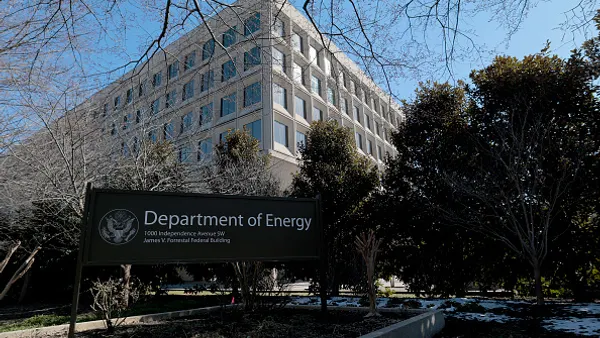Dive Brief:
- The U.S. Department of Energy’s Loans Program Office has provided a conditional commitment to Nostromo Energy for a loan guarantee of up to $305.5 million for its ice-based energy storage system.
- Nostromo Energy plans to use the proposed financing to scale up Project Icebrick, its thermal energy storage solution designed to integrate with virtual power plants. The system aims to reduce costs, cut emissions and alleviate strain on the electricity grid associated with significant energy use by HVAC systems in large commercial buildings, the company said in a news release this month.
- If finalized, the loan will support the installation of IceBrick systems in up to 193 commercial buildings across California, Nostromo Energy said. The DOE funding, alongside additional private sector capital, will enable the company to offer its technology to commercial buildings as a service, “where the building does not invest anything, but the system is fully paid for by sharing a portion of the savings and the wholesale market revenue stream,” Nostromo Energy CEO Yoram Ashery said in an interview.
Dive Insight:
Buildings consume 74% of all U.S. electricity, with approximately half used to maintain thermal conditions, representing the largest load on both buildings and the power grid, Nostromo Energy said. California is the second-largest total energy consumer by state, according to the Energy Information Administration. In a push to achieve climate goals, the state has set a target of building out a 100% clean energy grid and achieving carbon neutrality by 2045, according to a net-zero carbon pollution plan released by the California Air Resources Board in 2022.
Last year, the California Energy Commission approved a target to shift 7 gigawatts of load from peak to off-peak hours by 2030 — a goal that comes from a requirement in state Senate Bill 846 passed in 2023. “This goal will not be achieved without significant control of cooling energy loads,” Ashery said. “The IceBricks can provide cooling energy to the buildings for less than 50% of current cooling costs by charging at off-peak price hours and discharging during peak hours, and [offers] incremental VPP revenue, reducing carbon emissions by 200 to 300 metric tons a year over the system’s lifetime.”
Nostromo Energy submitted its loan application to DOE in the summer of 2022, according to a recent DOE blog post. If approved, Project IceBrick will deliver efficiency as a service by freezing a water-based solution during times of abundant, clean electricity. This stored ice will then cool buildings during peak demand periods, “when electricity production is dirtiest and most expensive”, DOE stated.
Nostromo’s Cirrus software enables IceBrick systems to operate as a VPP, coordinating multiple energy assets or functioning individually, DOE added. The agency noted that this load-shifting technology provides resilient power while also stabilizing the grid, complementing intermittent renewable energy sources critical to California’s goal of achieving 100% clean energy by 2045.
IceBrick systems can be retrofitted into existing buildings or integrated into new construction, as they are composed of compact and modular cells that are highly flexible in system size, layout and mounting location, according to Ashery. “The system can be located on a rooftop, parking lot, or in the basement near the chiller room and can be retrofitted in any building,” he said.
By connecting Nostromo Energy’s systems to the building's cooling system through a heat exchanger, the two systems can work in parallel and independently. Installation does not require turning down the HVAC system but connects to it while it is running, meaning there is no interruption to the building operation, he added.
The project could create over 200 direct jobs and the equivalent of more than 874 jobs annually over a five-year construction period, including hired installation contractors, Nostromo Energy said.
Project IceBrick represents the third virtual power plant project announced by the DOE LPO and the first to use cold thermal energy storage, DOE said in its blog. At full scale, the project could provide the equivalent of roughly 170 megawatts, or 450 megawatt hours, of behind-the-meter storage capacity for hotels, offices, data centers and other commercial buildings, DOE said.











